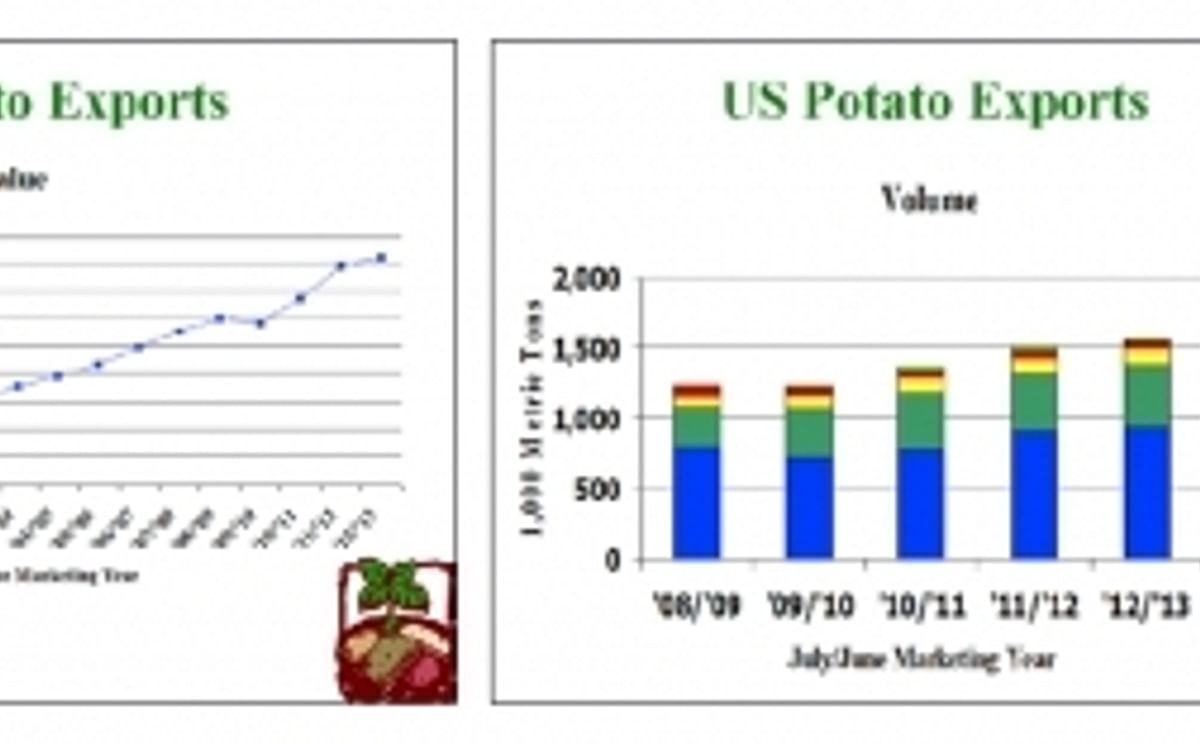Total US potato and product exports for FY13 (July 1, 2012 – June 30, 2013) increased 4 percent in value to $1,639,911,793 and also rose 4 percent in volume to 1,561,896 metric tons (MT)--both record levels. The fresh weight equivalent of these exports is 65,711,211 hundredweight, or approximately 17 percent of U.S. potato production.
U.S. potato and product exports have grown 133 percent in value and 79 percent in volume over the last 10 marketing years.
U.S. exports of frozen potato products in FY13 increased 2 percent by volume to 926,553 MT and 6 percent by value to $1,048,728,731. This is the first time exports of frozen products have surpassed the $1 billion mark. Exports to the USPB’s target markets increased 4 percent in volume. The increase in exports to target markets was led by a 28 percent increase in shipments to Mexico;26 percent increase to South Korea, 8 percent increase to Malaysia and a 15 percent increase to Vietnam. These increases overcame a 6 percent reduction in exports to Japan due to the 26 percent devaluation of the Japanese Yen which resulted in a curb on all imports.
U.S. exports of fresh potatoes to the world increased 13 percent by volume to 456,366 MT, but were down 4 percent by value to $196 million. Fresh exports include table-stock potatoes as well as chip-stock, and in the case of Canada, potatoes for frozen processing. The decline in the value of exports was mainly due to the reduction in unit value of exports to Canada and Mexico, though volume of exports to both markets did increase. Exports of fresh potatoes to the USPB’s target markets increased 24 percent in volume and 5 percent in value during FY13. The largest target market is Mexico with exports up 10 percent in volume to 79,719 MT. Exports to the targeted countries in Central America (table-stock and chip-stock) increased 47 percent to 11,761 MT. The Philippines (chip) grew 53 percent to 7,585 MT;Taiwan (chip and table-stock) was up 85 percent to 19,695 MT;Thailand (chip) rebounded up 32 percent to 11,533 MT;Japan (chip) increased 19 percent to 17,861 and Malaysia (chip and table-stock) was up 7 percent to 16,648. The newest market, Vietnam (chip and table-stock) increased 377 percent to 2,323 MT, while the traditional table-stock markets of Singapore and Hong Kong, were up 3 percent to 6,126 MT and 12 percent to 4,071 MT, respectively.
U.S. exports of dehydrated potatoes in FY13 were down 3 percent by volume to 114,408 MT, but stayed at virtually the same value of $192 million. Exports to the USPB’s target markets declined 3 percent in volume to 61,355 MT, and dropped 1 percent in value to $92 million. Exports to Mexico, the largest target market increased 4 percent to 22,466 MT, while exports to the second largest market, Japan, declined 11 percent to 19,813 MT, reflecting a 29 percent decline in total dehy exports to Japan. The U.S. lost market share to the EU in China and Korea, as short supplies in the U.S. in 2011 caused customers to switch to more plentiful supply from the EU, the continued lower price for this product has made it hard to get them to switch back to U.S. Good growth in U.S. exports was recorded for Indonesia, Thailand and Vietnam.
Export statistics for seed potatoes are unreliable as fresh potatoes get incorrectly categorized as seed and seed gets incorrectly categorized as fresh. The USDA figures show U.S. seed potato exports to all markets down 5 percent by volume and 8 percent by value to $8,251,919. However, USPB figures for its target markets show record levels of exports of 4,225 MT valued at $3 million, an increase of 40 percent over FY12 exports of 3,031 MT and $2 million. The biggest increase was in exports to Brazil which reached 1,050 MT after being zero in FY12. Exports to the Dominican Republic grew from 725 MT to 950 MT in FY13, while exports to Africa rose to 225 MT. Exports to Nicaragua, Uruguay and Sri Lanka were off slightly, but should rebound in FY14.
The United States Potato Board (USPB) anticipates U.S. potato and product exports to continue to grow in FY14 (July 2013 – June 2014). The size of future increases will be impacted by fluctuations in exchange rates, economic growth in the markets and the relative supply and price of competitor products. However, we know the opportunities will be there as the USPB international marketing program continues to create increased demand by demonstrating the high quality, excellent value, versatility and wide range of U.S. potatoes and products. The USPB also creates new opportunities for U.S. potatoes and products by opening new channels in the markets and gaining new market access such as just occurred for fresh table-stock to the Philippines.
Source: United States Potato Boar
United States Potato Exports Set another Record

Like to receive news like this by email? Join and Subscribe!
Get the latest potato industry news straight to your WhatsApp. Join the PotatoPro WhatsApp Community!
精选企业
Sponsored Content
Sponsored Content
Sponsored Content
Sponsored Content






